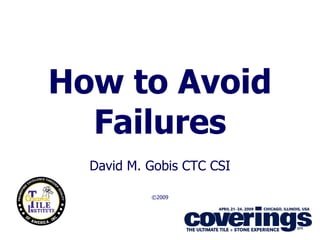Cov 09 How To Avoid Failure C
- 1. How to Avoid Failures David M. Gobis CTC CSI ┬®2009 1
- 2. Coverings is a Registered Provider with The American Institute of Architects Continuing Education Systems. Credit earned on completion of this program will be reported to CES Records for AIA members. Certificates of Completion for non-AIA members are available on request. This program is registered with the AIA/CES for continuing professional education. As such, it does not include content that may be deemed or construed to be an approval or endorsement by the AIA of any material of construction or any method or manner of handling, using, distributing, or dealing in any material or product. Questions related to specific materials, methods, and services will be addressed at the conclusion of this presentation. 2
- 3. Learning Objectives ŌĆó All tile and setting material is not created equal. Are yours up to the task? ŌĆó Tile Industry and substrate trades guidelines, valuable resouces. ŌĆó Is your available labor qualified to do the job? 3
- 4. Material Selection It is all about ŌĆóPlanning ŌĆóSelection ŌĆó Execution 4
- 5. Planning ’ā╝ The right materials for the application ’ā╝ The right method for the application ’ā╝ The right labor skills for the job 5
- 6. Proper Planning is About This Not this 6
- 7. Most Common Complaints ŌĆó Movement Joints ŌĆó Substrates ŌĆó Waterproofing ŌĆó Large Tile ŌĆó Thinsets 7
- 8. Substrate Issues 8
- 9. Appropriate Substrate Concrete American Concrete Tile Council of North America Institute American National Standards ŌĆó ACI 302.2R-21 ŌĆó F-113 ŌĆó CHAPTER 5ŌĆöFLOOR COVERING slab to be well cured, dimensionally AND ADHESIVE MANUFACTURERŌĆÖS stable, and free of cracks, waxy or oily RECOMMENDATIONS films, and curing compounds. ŌĆó 5.1ŌĆöIntroduction ŌĆó ANSI A108.01 The architect and engineer should ŌĆó 3.1.2.1 communicate to ensure that the ŌĆó Do not use liquid curing compounds or requirements for floor coverings in other coatings that may prevent Division 9 of Construction bonding of tile setting materials to Specifications Institute (2000) slabs. Use control joints through the specifications are compatible with slab and tile finish as specified or Division 3 requirements for concrete in where cracks are anticipated.ŌĆØ the same specification 9
- 10. Substrate Preparation Clean Bondable 10
- 11. Proper Substrate Preparation YES ! NO !!!!! 11
- 12. Wood Substrates 12
- 13. Appropriate Substrate Wood Engineered Wood Assoc. Tile Industry ŌĆó maximum variation in plywood surface shall not exceed 1/4" in10'-0" and 1/16" in 1'-0" from the required plane. Adjacent edges of plywood sheetsŌĆö www.apawood.or max. 1/32" above or below g each other. ŌĆó floor systems, including the framing system and subfloor panels, over which tile will be installed shall be in conformance with the IRC 13
- 14. Large Tile 14
- 15. Big Tile and Patterns Consider 1/3 offset with Make sure modular 12x24 tile patterns fit To minimize any natural warpage
- 16. This recent Standards revision now includes a category for Rectified Tile
- 17. Lippage Allowances (minus warpage) Tile Type Tile Size Grout Joint Width Allowable Glazed wall/Mosaics 1ŌĆØ x 1ŌĆØ to 6ŌĆØx6ŌĆØ 1/8ŌĆØ or less 1/32ŌĆØ Quarry 6ŌĆØ x 6ŌĆØ to 8ŌĆØx8ŌĆØ 1/4ŌĆ£ or greater 1/16ŌĆØ Paver (porcelain) All 1/8ŌĆØ to 1/4ŌĆ£ 1/32ŌĆØ Paver (porcelain) All 1/4ŌĆ£ or greater 1/16ŌĆØ 1/32ŌĆØ of an inch is .0312 or about the thickness of a credit card 1/16ŌĆØ of an inch is .0625 or about the thickness of a penny
- 19. Planning for Waterproofing ’ā╝The right materials for the application ’ā╝The right method for the application ’ā╝The right labor skills for the job 19
- 20. Appropriate Design 3 Years Old 2 Years Old 20
- 21. Appropriate Design One Year Old 21
- 22. Appropriate Design And Even More Bad Ideas 22
- 23. Appropriate Design Showers Need Effective Waterproofing Board set Door on tub Nail Waterproofing 23
- 24. Appropriate Design Plumbing code may be insufficient to protect the structure 24
- 25. Enhanced? Appropriate Design Consider waterproofing the entire area at the surface 25
- 26. Thinsets 26
- 27. Mortar / Dry-Set / Thin-set Confusing Terminology ŌĆó ANSI 118.1 Dry-Portland Cement (Un-modified Thin-set) ŌĆó ANSI 118.4 Latex or Polymer-Portland Cement Mortar (Modified Thin-set) ŌĆō Wall Tile Thin-set Mortar (Non-Sag Mortar) ŌĆō Crack Prevention Mortar (Flexible Thin-set) ŌĆō Complete Contact Mortar (No Back Buttering over flat surfaces) ŌĆō Rapid Setting Mortar (allows grouting and foot traffic faster) ŌĆō Medium Bed Mortars (Apply up to ┬ŠŌĆØ without excess shinkage ) ŌĆō ANSI 118.11 EGP Latex Mortar (Thin-set Over Plywood)
- 28. Get Specific Recommendations for Glass Tile 28
- 29. Not All Thinsets Suitable for Exterior Use 29
- 30. Ceramic Tile is NOT Structural Always make sure the method used for installation provides at least 80% coverage equally distributed, 95% in wet areas or exterior applications.
- 31. Dots DonŌĆÖt Work! 31
- 32. Ridges, Exterior Deck, Freeze/Thaw 32
- 33. Movement Joints 33
- 34. Always Provide Movement Joints ŌĆó interior ŌĆö 20ŌĆÖ to 25' in each direction. ŌĆó exterior ŌĆö 8' to 12' in each direction. ŌĆó interior tilework exposed to direct sunlight or moisture ŌĆö 8ŌĆÖ to 12' ŌĆó where tilework abuts restraining surfaces ŌĆó same as grout joint, but not less than 1/4".
- 35. Incorporated into Every Job 35
- 36. Recent Job 36
- 37. The Question is NOT Will There be Movement It Is How Much 37
- 38. Questions? Dave Gobis Independent Technical Consultant 262-994-1175 dave@ceramictileconsultant.com ┬® 2009 38





































